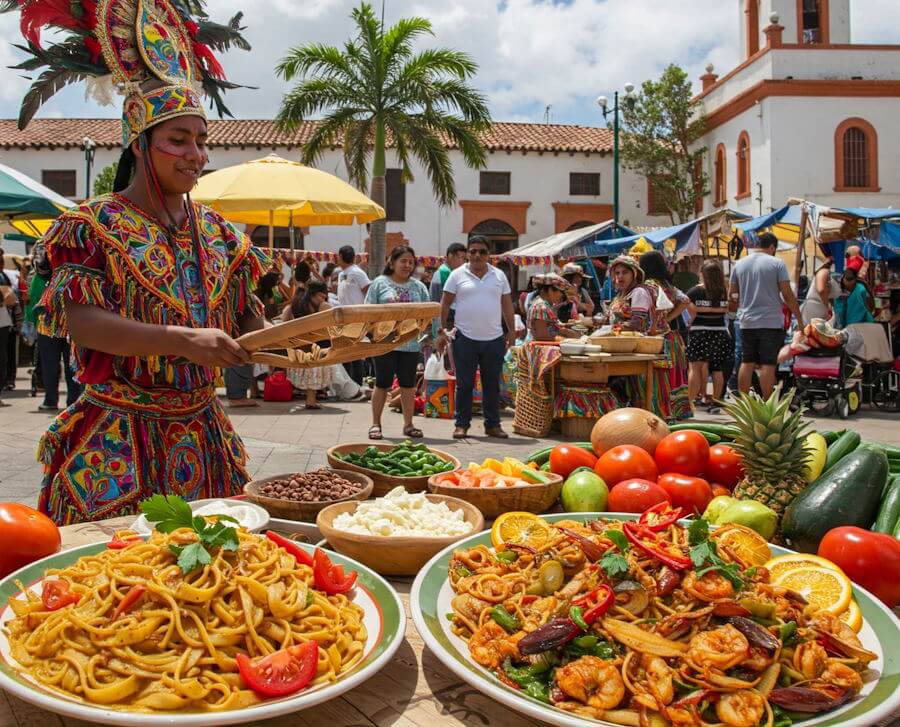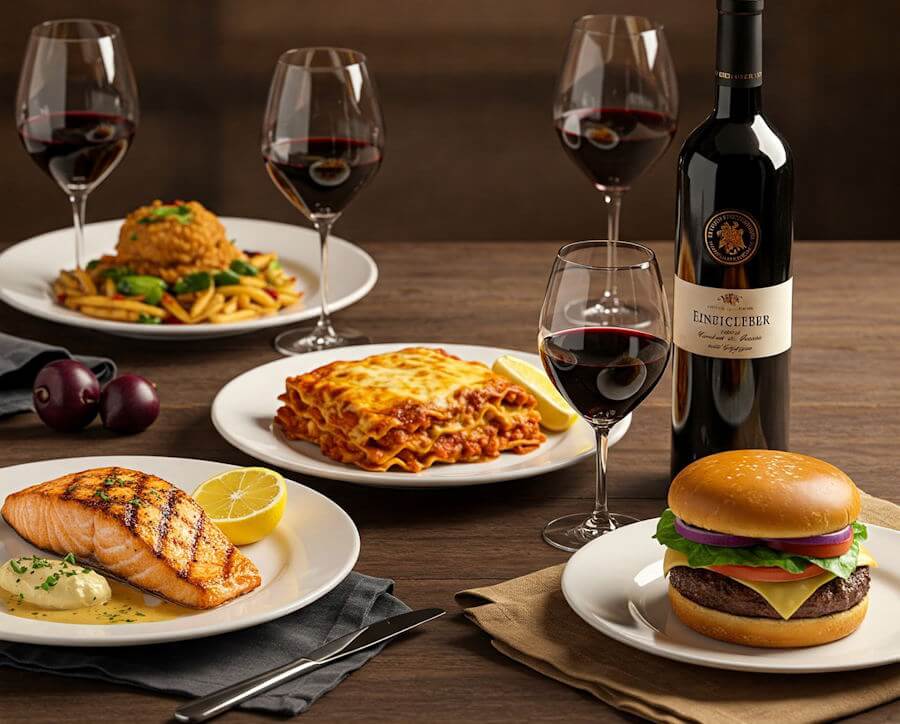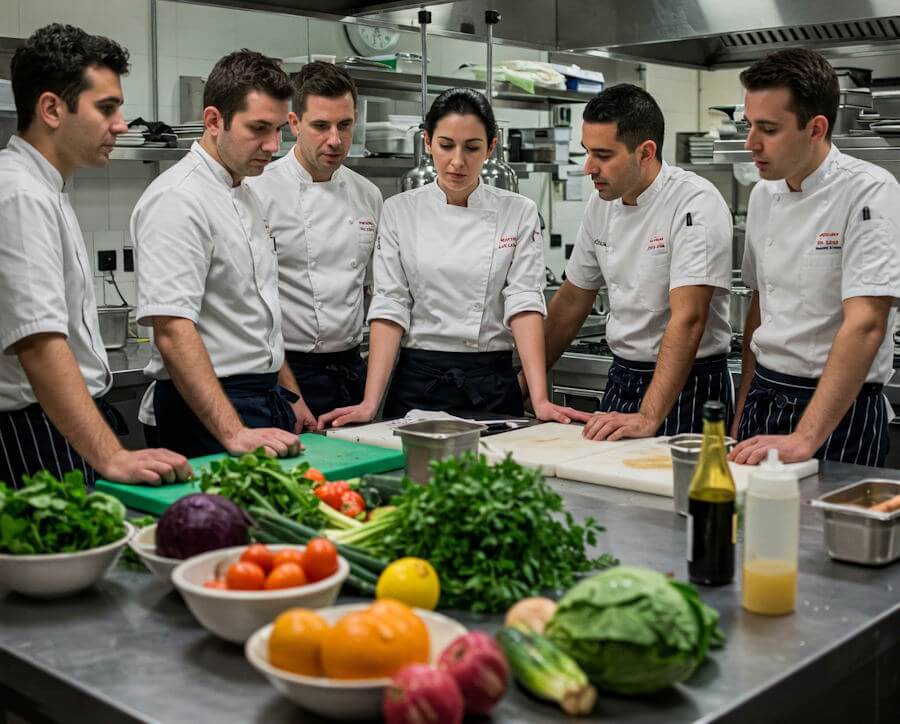Introduction to Culinary Fusion
Culinary fusion refers to the innovative combination of ingredients, techniques, and traditions from different cultures to create unique and diverse dishes. This concept has evolved significantly over time, reflecting globalization and cultural exchange. It can be traced back to various historical moments when trade routes opened up new possibilities for food, with spices and cooking methods crossing borders and enriching local cuisines. The idea of blending culinary traditions is not entirely new; for centuries, communities have adapted and transformed their local food practices by incorporating elements from neighboring or distant cultures.
In contemporary dining, culinary fusion has gained immense popularity, appealing to a broad audience eager for novel taste experiences. This trend can be attributed to the growing accessibility of global ingredients, the rise of multicultural societies, and the easy exchange of culinary knowledge through travel and migration. Chefs and home cooks alike are emboldened to experiment with flavors and presentations that challenge traditional norms, often resulting in dishes that beautifully showcase the art of blending local traditions with international flavors.
The significance of culinary fusion lies not only in its ability to create innovative dishes but also in its celebration of diversity and heritage. By merging traditional recipes with modern twists or foreign elements, chefs can honor the roots of various cuisines while also appealing to contemporary palates. This culinary innovation promotes a deeper appreciation for food culture and allows for a gastronomic dialogue among different communities. Ultimately, the practice of culinary fusion is more than just a trend; it represents a dynamic way of experiencing and understanding the world through food.
Understanding Local Culture’s Influence on Cuisine
The interplay between local culture and cuisine is a dynamic relationship that shapes food preferences, cooking styles, and overall gastronomic experiences. This interaction is profoundly molded by various elements including traditions, ingredients, and methods of preparation that are unique to specific regions. Understanding the nuances of local culture reveals how these components lay the groundwork for the fusion of local and global flavors.
Traditions play a pivotal role in defining what communities consider acceptable and desirable food. Festivities, seasonal events, and religious ceremonies often dictate specific dishes, creating a strong cultural identity tied to food. For instance, in many Mediterranean locales, communal dining plays a vital role where sharing meals fosters a sense of togetherness. These traditions not only influence the types of food consumed but also the methods through which they are prepared and presented, emphasizing the importance of flavor and sustainability, particularly in local sourcing of ingredients.
Regional ingredients significantly contribute to the distinctiveness of local cuisines. The availability of certain produce, herbs, and spices often determines the flavors emblematic of a region. For example, the use of fresh seafood in coastal communities or the integration of indigenous grains in rural areas underscores how local resources shape culinary practices. Such ingredients are often the backbone of dishes that become staples, making them integral to local identity.
Cooking methods, too, vary considerably from one culture to another, influenced by geographic, climatic, and historical factors. Techniques such as grilling, steaming, or slow-cooking enable different textures and flavors to emerge in dishes, further enhancing their cultural significance. This diverse array of methods provides an enriching platform for blending with global cuisine, facilitating the creation of innovative dishes reflecting both local and international influences. In conclusion, the synergy of tradition, ingredient availability, and preparation techniques within local cultures forms a robust foundation for culinary fusion. Through understanding these elements, chefs and food enthusiasts can embrace and elevate global flavors while honoring their origins.
The Role of Global Cuisine in Modern Cooking
In today’s culinary landscape, the role of global cuisine is increasingly pivotal, shaping dining experiences worldwide. The advent of globalization has facilitated a remarkable exchange of culinary practices, allowing various cultures to infuse their traditional recipes with international influences. This blend not only enhances flavor profiles but also introduces diners to unique flavor combinations that might have been previously unheard of in their local cuisine.
One significant impact of global cuisine on local dining is the widespread availability of international ingredients. Markets, both physical and online, now offer a plethora of exotic spices, sauces, and produce that were once relegated to specialty shops. For example, ingredients such as miso from Japan or harissa from North Africa have found their way into local kitchens, enabling chefs and home cooks to explore different flavor paradigms. By utilizing these ingredients, they can create dishes that honor their cultural roots while simultaneously embracing a broader culinary narrative.
Furthermore, modern cooking techniques derived from various global cuisines have become integral to contemporary culinary arts. Techniques such as sous vide from French cuisine, tandoor cooking from Indian traditions, or stir-frying from Chinese practices allow chefs to experiment with textures and flavors in innovative ways. This cross-pollination of methods has led to the emergence of unique dishes that reflect a harmonious blend of local and global influences, thereby enhancing the richness of local culinary offerings.
Trends in dining, such as fusion cuisine, have catalyzed this process even further. The blending of distinct culinary traditions into cohesive dining experiences has gained popularity, attracting diners eager for novelty. Through this interplay of global influences, chefs can craft menus that are both diverse and reflective of a multicultural society, resulting in dining experiences that are as enriching as they are delicious.
Innovative Pairing Techniques
In the realm of culinary arts, innovative pairing techniques have emerged as a vital approach for chefs aiming to blend local culture with global cuisine. These strategies enhance the sensory experience of dishes while respecting the origins of ingredients and cooking methods. A fundamental technique involves the use of local ingredients in global recipes, allowing chefs to create familiar yet novel dishes. For instance, a recipe for a classic Italian risotto can be transformed by incorporating local seafood or vegetables, infusing regional flavors without compromising the essence of the original dish.
Another effective strategy is fusion cooking, which involves combining elements from different culinary traditions. A prime example is the sushi burrito, which merges traditional Japanese sushi with the convenience of a burrito, offering portability while introducing diverse textures and flavors. This innovative dish not only showcases the versatility of sushi but also highlights the influence of cultural exchange in modern gastronomy.
Case studies further illustrate successful culinary pairings that serve as benchmarks for innovation. For instance, a popular dish from a Mexican restaurant in California features tacos filled with Korean barbecue. This blend of flavors articulates how chefs can integrate distinct culinary identities into cohesive dishes, enticing a broader audience while celebrating diverse heritages. In such examples, the key to success lies in achieving a harmonious balance between authenticity and innovation. Chefs must carefully evaluate the essence of each cuisine they wish to incorporate, respecting culinary traditions while embracing change.
Ultimately, these innovative pairing techniques underscore the importance of creativity in the culinary world. The melding of local culture with global cuisine not only enriches the dining experience but also fosters an appreciation for diversity in food. By continuing to explore and experiment with flavors from around the world, chefs play a pivotal role in shaping the future of culinary practices.
Spotlight on Successful Fusion Restaurants
As the culinary landscape continues to evolve, fusion restaurants have emerged as a vivid testament to the seamless blend of local culture and global cuisine. A prime example is “Bistro Fusion,” located in the heart of a bustling city, where Chef Maria Gonzalez creates dishes that reflect her Mexican heritage while drawing inspiration from Asian culinary techniques. She emphasizes the importance of embracing diverse flavors, stating, “The beauty of cooking lies in its ability to transcend borders. Each ingredient has a story, and when combined with others, it creates something truly unique.” One of her signature dishes, the Szechuan Tacos, features traditional corn tortillas filled with slow-cooked pork infused with spicy Szechuan sauce, garnished with fresh cilantro and lime, embodying the harmonious marriage of two culinary worlds.
Another notable establishment, “MediterrAsian Delight,” led by Chef Kenji Tanaka, showcases the essence of Mediterranean and Asian cuisine. Chef Tanaka found his inspiration during travels through the Mediterranean, where he encountered the vibrant spices and cooking methods of both regions. His creation, the Miso Hummus, has gained a loyal following, featuring a smooth blend of chickpeas, tahini, and miso—perfect as a dip or spread, it highlights the versatility of both cultures. Chef Tanaka believes, “The fusion of flavors offers diners an exciting adventure; it’s about presenting familiar tastes in unfamiliar ways.”
Lastly, “Spice & Smoke,” opened by partners Amina Al-Hassan and Marco Rossi, illustrates the intricate dance between Indian and Italian cuisines. Their standout dish, Tandoori Risotto, incorporates traditional Italian risotto infused with tandoori spices, providing a creamy and spiced Italian classic with an Indian twist. The team emphasizes that successful fusion comes from a deep respect for each cuisine, stating, “We aim to preserve the soul of each culture while creating something novel.” These restaurants not only tantalize taste buds but also foster a greater appreciation for culinary diversity in our globalized world.
Challenges and Controversies of Cultural Appropriation
Cultural appropriation in cuisine is a pressing issue that has generated significant debate among chefs, food enthusiasts, and cultural advocates. The fine line between appreciation and appropriation becomes particularly pronounced when global culinary elements are incorporated into local dishes. While it is natural for culinary traditions to evolve and intermingle through globalization, understanding how to respect the origins of these flavors is crucial in avoiding cultural insensitivity.
One of the primary challenges lies in distinguishing between genuine appreciation for a culture’s culinary heritage and the potential for appropriation that can lead to the commodification of traditional dishes. When chefs adopt elements from other cultures without acknowledging their roots or significance, it can diminish the importance of those traditions, making them appear simply as trendy concepts instead of deeply rooted practices. This practice can lead to backlash, particularly when the chefs benefitting from these adaptations belong to cultures that have historically marginalized the original culinary practices.
Incorporating global elements ethically requires chefs to engage with the source culture meaningfully. This includes researching the history of the dish, understanding its components, and if possible, collaborating with those from the tradition they wish to showcase. Such collaborations can help foster mutual respect, leading to the creation of dishes that honor the origins while enriching the local menu. Furthermore, it is essential for chefs to consider their motivations in adopting these flavors; are they genuinely attempting to build bridges between culinary traditions, or are they primarily pursuing novelty for financial gain?
Understanding these nuanced challenges forms the basis for respecting cultural origins in cuisine. By focusing on authentic engagement and valuing the traditions that influence the fusion of flavors, chefs can successfully navigate this complex landscape and create dishes that resonate with both local and global audiences.
The Impact of Globalization on Local Flavors
Globalization has significantly transformed the culinary landscape, leading to a dynamic intersection of local flavors and global cuisine. This phenomenon facilitates the exchange of ingredients, cooking techniques, and traditions, resulting in an evolving dining experience that can both enrich and challenge local culinary identities. As culinary practices merge, many communities have reported a revitalization of their traditional dishes, often incorporating exotic spices or cooking methods sourced from far-flung cultures. The incorporation of these global elements allows local chefs to innovate, creating novel dishes that appeal to a more diverse palate.
However, the impact of globalization on local flavors is not uniformly positive. One of the notable drawbacks is the risk of cultural homogenization, where unique local cuisines may gradually diminish under the encroaching influence of more dominant culinary traditions. This could lead to a scenario where the distinctive characteristics that define a particular cuisine become overshadowed by global trends. As international dining options proliferate, local establishments may struggle to compete, potentially forcing them to compromise their traditional practices in favor of more commercially viable offerings.
Despite these challenges, globalization can also serve as a catalyst for cultural preservation. By raising awareness of local dishes on a global platform, communities can showcase their culinary heritage, thereby attracting interest from both locals and tourists. Moreover, the blending of flavors allows for a dialogue between cultures, fostering appreciation and understanding of diverse culinary traditions. Ultimately, while globalization presents certain challenges to local flavors, it also offers opportunities for growth and evolution. Embracing these influences, while maintaining an emphasis on authenticity, can lead to a rich tapestry of culinary innovation that honors both local heritage and global diversity.
Tips for Home Cooks to Create Fusion Recipes
Creating fusion recipes at home can be an exciting culinary adventure, offering a unique way to combine flavors from different cultures. To embark on this journey, home cooks should start by understanding the essence of the cuisines they wish to blend. Researching traditional cooking methods and regional ingredients will provide a solid foundation for experimenting with taste combinations.
When selecting ingredients for fusion cuisine, consider using local produce alongside global spices and staples. For instance, incorporating fresh herbs common in your region—such as basil or cilantro—can enhance global dishes, while vegetables like zucchini or bell peppers can easily fit into various international contexts. Aim for a balance between familiar flavors and exotic elements, ensuring that no single component overwhelms the dish. A harmonious blend is key to successful fusion recipes.
Balancing flavors is another crucial aspect of creating fusion dishes. Different cultures typically favor certain flavor profiles, such as the sweetness of Vietnamese cuisine or the spiciness of Indian dishes. Experiment with ingredients that complement each other well; for example, combining the spiciness of Thai chilies with the earthy sweetness of Japanese miso can create an extraordinary depth of flavor. Use citrus, acid, or salt to enhance these combinations when necessary.
To explore local and global food pairings, consider starting with traditional recipes and reimagining them with a twist. Perhaps a classic tomato sauce could be enriched with curry spices, transforming it into a delightful fusion sauce for pasta. Another approach can be reinterpreting tacos by filling them with fresh sushi ingredients. The possibilities are limitless when you allow creativity to guide your cooking process.
Finally, remember that trial and error are part of this journey. Maintaining an open mind and being willing to adjust recipes will help refine your fusion cooking skills over time. Enjoy the process and have fun while introducing new global flavors into your everyday meals.
Conclusion: Embracing the World through Food
As we reflect on the rich tapestry of flavors that fusion cuisine offers, it becomes increasingly clear that food serves as a powerful medium for cultural interchange and creativity. The act of merging local ingredients with global culinary techniques not only results in tantalizing dishes, but it also exemplifies the beautifully intertwined nature of our societies. Each meal becomes a celebration of diversity, merging tastes, and traditions from various corners of the world.
Engaging with fusion cuisine invites individuals to step outside their gastronomic comfort zones, encouraging an exploration of unfamiliar flavor profiles and cooking methods. This culinary adventure can instill a sense of curiosity about global cultures and deepen one’s appreciation for various culinary heritages. Emphasizing the essence of global flavors, one can enhance their own cooking by integrating techniques and ingredients that may not be typically found in local kitchens.
Furthermore, the act of cooking offers a unique opportunity for personal and communal connection. When family and friends gather around a table filled with blended cultural dishes, it fosters camaraderie, storytelling, and shared experiences, illustrating how food transcends boundaries. This communal aspect of dining is vital for encouraging broader acceptance of diverse cultures, as flavors connect people in ways that words sometimes cannot.
In conclusion, embracing the world through food provides us with the opportunity to celebrate diversity in all its forms. By actively engaging in fusion cuisine, we not only enhance our own culinary skills but also cultivate a greater understanding and respect for the vibrant mosaic of traditions that comprise our global community. Let this exploration guide your culinary journey, allowing your palate to traverse the globe, one dish at a time.





